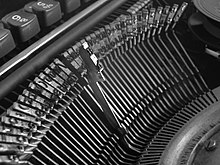Typewriter type
The types of typewriters , similar to the letters in letterpress printing , are bodies that carry the raised, mirror-inverted image of the characters . In contrast to the letters, however, the types are not intended for loose use, but either permanently connected to components of a typewriter or, in larger quantities, form a component themselves.
At the upper end of a type lever there are usually two characters on top of each other in today's form (e.g. "h" and "H"), which can be selected accordingly by pressing the shift key . In mechanical typewriters, the toggle button either raises the platen or the entire platen carriage (roller switchover or carriage switchover) or raises or lowers the segment basket (segment switchover). Typewriters without switching have only one type per type lever. The type has the shape of a U-profile and is plugged directly onto the steel type lever and soldered . It is often chrome-plated or nickel-plated to counteract mechanical wear. However, it does happen that a type or its soldering breaks. In such cases the office machine mechanic can solder on a new type or fix the old type again by soldering. Some practical experience is required for this; the loose type must be very finely adjusted on three axes before it is finally soldered. Today it will be difficult to find someone with the necessary skills. Some companies used special types in their business correspondence (e.g. with their own company logo), which could be attached by the office machine mechanic.
A type wheel is a wheel made of sturdy but elastic plastic with many spokes, each of which has a single type attached to its end. Compact type wheels without spokes are used for the (manual) production of embossed labels .
A type roller or a typewriter ball head is a metal or metallized plastic body on which the types are arranged radially and in several levels one above the other.
Certain printing calculating machines also have typewriter types as “writing machines”. Initially, individually movable types (e.g. the number 7 or a +), but later mainly type bars (e.g. with the numbers 0 to 9) were implemented. On the type bars with arithmetic symbols, individual spaces for types were often unused.
